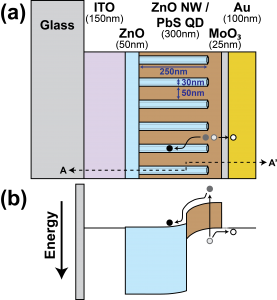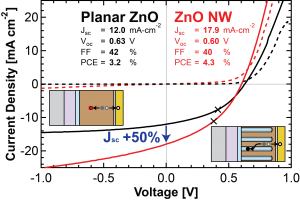ZnO Nanowire Arrays for Enhanced Photocurrent in PbS Quantum Dot Solar Cells
- Category: Electronic Devices, Energy, Materials, Nanotechnology
- Tags: joel jean, vladimir bulovic
Here we demonstrate a solution-processed ordered bulk heterojunction quantum dot (QD) solar cell with AM1.5G power conversion efficiencies of up to 4.9%, the highest reported performance for a QD solar cell based on ZnO[1]. Solid-state QD photovoltaics (QDPVs) constitute the most recent addition to the NREL photovoltaic efficiency charts, with most reports focusing on an inverted heterojunction between a wide-bandgap n-type metal oxide (ZnO or TiO2) and p-type lead sulfide (PbS) QDs. Despite rapid improvements in performance over the last several years, these devices remain limited by a narrow depletion width and hence a fundamental trade-off between light absorption and carrier collection. We find that vertically aligned arrays of ZnO nanowires can orthogonalize absorption and collection, as shown in Figure 1. The nanowires penetrate into the photoactive QD film and increase the effective depletion width, allowing efficient extraction of photogenerated charges from deep within the film. After optimizing the nanowire growth and device fabrication processes, we show that incorporating nanowires boosts both the photocurrent and the efficiency of planar QDPVs by over 35% (Figure 2).
The primary contribution of this work is the integration of bottom-up-grown 1-D ZnO nanostructures with PbS nanocrystals, the leading material system for QDPVs. While ZnO/PbSe[2] and TiO2/PbS[3] bulk heterojunction devices have been demonstrated, we report the first ZnO/PbS bulk heterojunction QD solar cell and show that a bottom-up solution process can produce nanostructure alignment and device performance on par with that of top-down synthetic processes. The simple hydrothermal ZnO nanowire growth process[4] is well characterized and compatible with a variety of substrate and electrode materials at low temperatures[5]. Our work on scalable bottom-up processing of ZnO nanowire-based QD solar cells suggests that 1-D nanostructures may be the key to enhancing the efficiency and hence the economic viability of QDPVs.
- Figure 1: (a) Schematic and (b) energy band diagram at short-circuit (cross-section along A-A’) of an ordered bulk heterojunction QDPV device. An array of ZnO nanowires decouples light absorption from carrier collection, extending the effective depletion width throughout a thick QD film.
- Figure 2: J-V characteristics under AM1.5G illumination for representative planar (black) and nanowire-based (red) QDPV devices. Incorporating ZnO nanowires boosts the short-circuit current density (JSC) and the power conversion efficiency (PCE) by 50% and 35%, respectively. Black crosses indicate the maximum power point.
- J. Jean et al., “ZnO nanowire arrays for enhanced photocurrent in PbS quantum dot solar cells,” Adv. Mater., vol. 25, no. 20, pp. 2790-2796, May 2013. [↩]
- K. S. Leschkies et al., “Nanowire-quantum-dot solar cells and the influence of nanowire length on the charge collection efficiency,” Appl. Phys. Lett., vol. 95, no. 19, Nov. 2009. [↩]
- I. J. Kramer et al., “Ordered nanopillar structured electrodes for depleted bulk heterojunction quantum dot solar cells,” Adv. Mater., vol. 24, no. 17, pp. 2315-2319, Mar. 2012. [↩]
- L. E. Greene et al., “General route to vertical ZnO nanowire arrays using textured ZnO seeds,” Nano Lett., vol. 5, no. 7, pp. 1231-1236, June 2005. [↩]
- H. Park et al., “Graphene cathode-based ZnO nanowire hybrid solar cells,” Nano Lett., vol. 13, no. 1, pp. 233-239, Dec. 2012. [↩]

